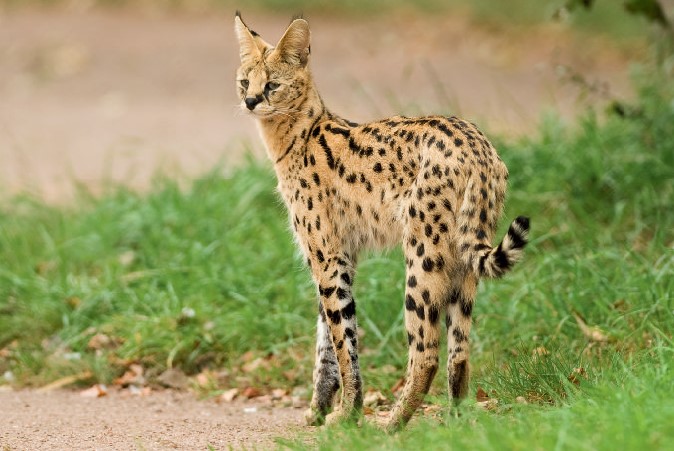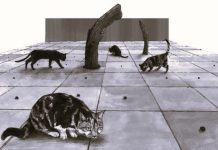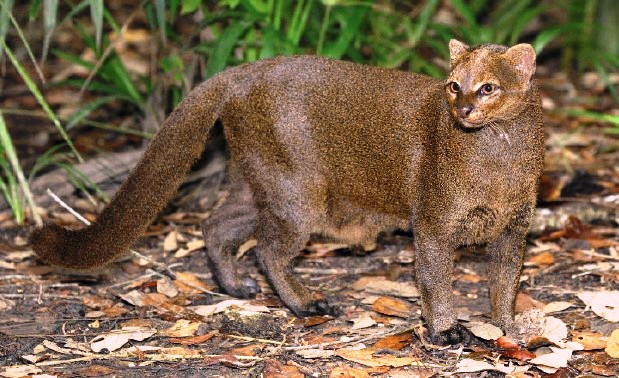A Serval Cat (Leptailurus serval) spotted shape becomes indistinct and reappears as a light breeze shuffles the grass on Tanzania’s Serengeti Plain. He still waits like a sentinel, his long legs still erect. There is a trance about its eyes, but its enormous, dish-shaped antenna ears turn slowly, listening intently. The ears remain open for a few minutes, and then the sound is pinpointed. The cat floats over the meter-high grass after two cautious steps. Every time the rat moves, its body turns and swerves in midair.
There is a slam of two forepaws into the dirt. It connects with the pounce. Another meal has been secured. The Serval Cat is a member of the cat family that is highly specialized, like the cheetah. Stalking through the grasslands on their stilt-like legs, the Serval Cat looks strangely un-catlike. These tall, lightly built cats have small, slim faces dominated by large oval-shaped ears. Rather than the sleek, muscular, crouching body plan of most felids, Serval Cats seem designed for maximum height.

For its size, the Serval Cat has the longest legs and feet of any cat family member; it stands as tall as a German shepherd dog but weighs only half as much. Strictly speaking, it is not the length of the Serval Cat’s legs that allows it to tower over other cats, but the length of its feet. Elongated metatarsal bones in the Serval Cat’s feet add extra inches to this cat’s height. Long legs usually mean speed, but the Serval Cat is not a particularly fast runner; rather, its legs are large so it can hear well.
For sound-hunting to work efficiently, ears need an elevated platform. Serval cats are so tuned into noises that they often stop and sit with their eyes closed for ten minutes or more. They turn their heads and listen. Unless they are extremely hungry, cats rarely hunt in windy weather. Wind noise interferes with their ability to pinpoint prey sounds moving through the grass.
A Serval Cat pounces like a fox, springing high with all four feet off the ground. If the first attempt fails, the cat follows its prey, chin tucked into its chest, tail up. It bounces high into the air in a swift succession of still-legged jumps. This capriole jump, in which all four feet are off the ground at once, is a typical hunting technique.
This high-bouncing pounce is also used by Serval Cats in order to flush animals from their cover. They gallop through the grass in a zigzag pattern, leaping high into the air; anything that moves is caught immediately. Serval Cats are prodigious leapers— their jumping abilities rival caracals. A single pounce spans 12 feet. They have been seen leaping 6 to 10 feet into the air to knock down a bird or insect in flight. Besides providing a vantage point for the Serval Cat to “hear into” tall grass, this cat’s long legs also pack a powerful punch.
The Serval Cat uses its front feet to deliver formidable blows that kill or stun prey. When hunting larger animals that might fight back, the Serval Cat springs into the air, strikes with all four feet, bites, and then leaps away. Serval cats can kill large snakes by bashing them with swift hammer-like blows. Not many cats are known for their digging abilities, but Serval Cats can and often dig for their meals. Huge ears make their hearing so acute that they can locate prey underground. They use their long mobile toes and strong claws to hook rodents and fledgling birds out of tunnels.
One young Serval Cat was seen standing on his hind legs, poking the tip of his front paw into the nest holes of a colony of swallows. Serval cats have also learned a highly refined “dig and wait” hunting technique to catch African mole rats. Mole rats live exclusively underground, so cats cannot see them. A Serval Cat locates a mole rat tunnel, scratches a hole in it, then sits and waits with one paw praised. This is ready to capitalize on the fact that mole rats usually repair tunnel damage.
At the first sign of movement, the Serval Cat slams its paw down, hooks the mole rat, and flings it away. It follows with a lightning pounce before the stunned victim recovers. Whether it is feeding on frogs, mice, or fledgling birds, the Serval Cat’s long ears, un-catlike shape, and specialized hunting technique translate into more meals per pounce than the average cat. Most cats are lucky to get a meal every ten hunting attempts. However, nearly one of every two Serval Cat pounces results in a kill, which makes it one of the most successful feline hunters. A single Serval Cat kills 4,000 rodents and 250 snakes annually.
Though they sometimes kill storks, flamingoes, and young antelopes, Serval Cats survive on small prey. Most of the Serval Cat’s diet is made up of animals weighing less than 7 ounces (200 g)—less than 2 percent of an average female’s body weight. Serval Cats hunt in the early morning and late afternoon, but females have to step up their efforts when they have kittens; mothers have to spend the day hunting.

When the kittens are a month old, the female brings food back to the den. Biologist Aadje Geertsema, who studied Serval Cats in Tanzania, watched one Serval Cat mother carry a mouse 1,750 feet (1.6 km) to the spot where her three kittens were hidden in some reeds.
When she was about 165 feet from the den, the female started to call, stopping occasionally to listen for an answer. Near the den, the three kittens ran out to meet their mother. One picked up the mouse; while the other two settled down to suckle.
As the kittens get older, it becomes more difficult for the mother to persuade them to stay at the den site. This is while she hunts. Geertsema watched one mother spend more than an hour growling and spitting at her kitten before she could hunt.
Moreover, the Serval Cat exploits high rodent populations in open grasslands and woodlands due to its physical and behavioral specializations. These specializations are very similar to those found in the dog family, a group that also preys extensively on small rodents in open habitats. With its large ears, slim face, and long legs, the Serval Cat resembles a fox or a manned wolf rather than a cat. The Serval Cat’s hunting behavior is similar to a dog.
High-bouncing pounces, scanning for sounds, and digging are all hunting behaviors shared more with the dog family than with cat family members. Like foxes, the Serval Cat thrives on rats and mice that work hand in hand with agricultural activity. They are quite common in rural areas in many parts of Africa.
As long as they are not persecuted, these graceful, long-legged cats can survive in man-altered habitats and even benefit humans. These cats are portrayed as gifts or traded objects from Nubia in ancient Egyptian art. They are rarely kept as pets.
Status: IUCN Red List—Least Concern
Weight: 15–40 pounds (7–18 kg).
Head-body length: 24–36 inches
Tail length: 8–15 inches
Litter size: 1–4 kittens

Read More – Bobcat (Lynx rufus)






